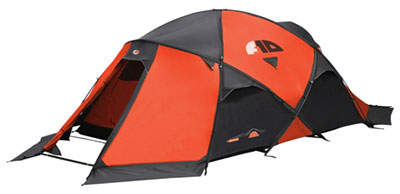Force Ten Vortex 200 Tent
Product Review & Walking Gear Test
 |
 Vortex 200 Tent Vital Statistics: Weight: SRP: |
Features to Note:
- Geodesic design
- Pitching time (claimed) 15 mins
- Pack Size: 47x19 cms
- Flysheet: Protex ® 5,000mm SPU ripstop nylon 400D
- Breathable ripstop nylon inner
- HD nylon groundsheet
- Flat pole sleeves
- F10 Flexlite, colour coded, pre-angled poles
- Porch snow valances
- Front & rear access
- Flysheet vents closable from inner
- Gear loft
- Part mesh inner door
In-use Test:
Force Ten is a well recognised name amongst afficonados of tents for use in more challenging environments.
The Vortex 200 is part of the Force Ten 'Expedition' range and according to the manufacturer is designed 'for the most volatile of environments'. As such it does have features such as a full geodesic shape, snow valances at front and rear entrances plus a robust looking 40D flysheet. My testing so far has been over several nights in the relatively benign Staffordshire Dales ... so it's fair to say that I've not yet tested it to its full capability!
To help in adverse weather conditions, the Force Ten Vortex 200 offers all-in-one pitching straight out of the bag, so the whole thing goes up in one go so you can quickly get out of the rain or snow and get a brew on.
Pitching was reasonably straightforward despite the fact that the instructions were pretty confusing (they seemed to refer to poles which were a different colour to those with the tent). It does take a bit of fiddling to insert the poles into the sleeves - I imagine with cold hands it would be even more aggravating. Basically there are two straight poles which go diagonally across the tent then two bent ones which form the over-the-doors support. It's important to insert all the poles before attempting to raise the tent. After that, the pegging out and tensioning of guy-lines can be done quite quickly.
Despite our initial grief, I think the 15 minutes claimed pitching time is a little long. After the initial run-through, we've been doing it in less that ten minutes. As I said, the key here is to insert all the poles into their respective sleeves before inserting the ends into their location rings to create the geodesic shape - we initially struggled with this bit for quite a while.
Once inside there's a pleasant orangey-light giving the interior a quite relaxing feel. There's a generous amount of space for two people and the porches front and back mean there's a decent amount of space for stashing gear not needed inside and/or for cooking. There's also storage pockets all around the inside plus a small gear 'loft'. At 5'10'' I found it possible to sit-up very comfortably in the central areas and to lie down to my full length. However - if you were 6' or over you might struggle to sleep full length.
There are four ventilation points in the body of the tent plus one in each door. Rather unusually - and very flexibly - at each of these points you can reach through the mesh covered opening in the interior to adjust the size of the ventilation point in the exterior flysheet. I wasn't conscious of any undue condensation during several end-of-summer nights spent in the Vortex.
Thus far it seems to me to be a rock-solid tent with a good build quality and I look forward to trying it out for some winter/high mountain camping trips.
You might consider an lighter option if you don't need quite this degree of protection. However - robust by virtue of its geodesic design - the Vortex is an extremely solid, understated looking 3-4 season tent for nights at low level or in higher UK mountain areas. We love it.
Have you got a Force Ten Vortex 200 Tent?
We would love to hear what you thought of it - good, bad or indifferent. Perhaps you simply disagree with the verdict above - or feel an important feature has been negelected.
Let us know by clicking this link - What I think of Force Ten Vortex 200 Tent - so we can publish your important views below.




















